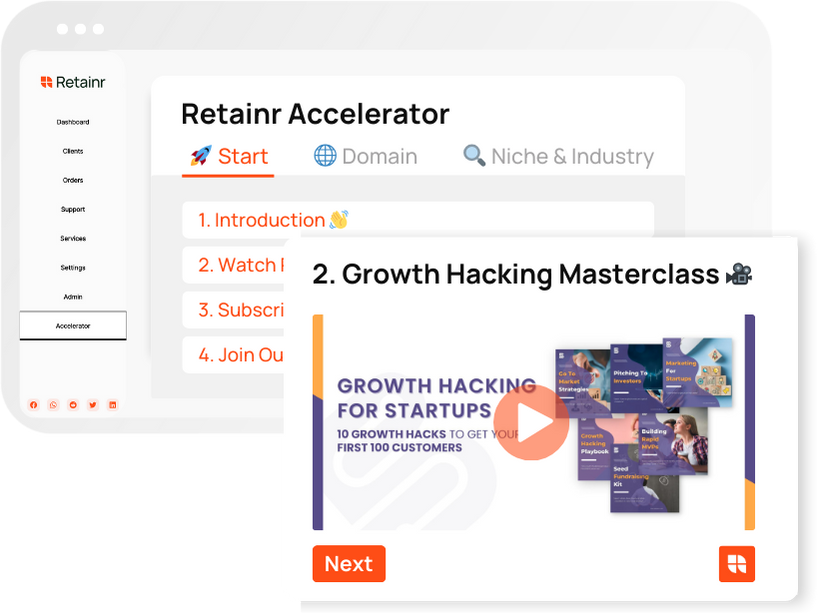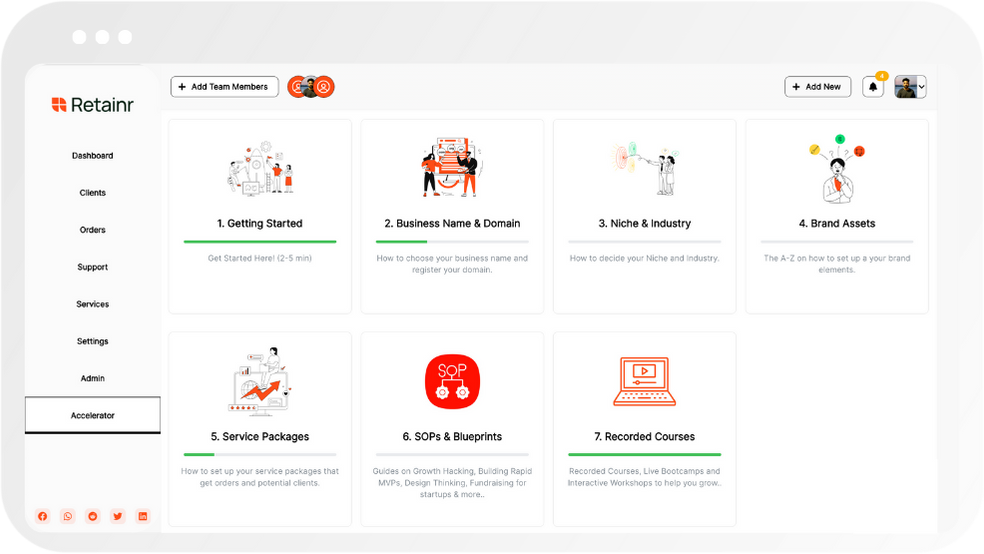
Automating Workflows: A Beginner's Tutorial
Build with Retainr
Sell your products and services, manage clients, orders, payments, automate your client onboarding and management with your own branded web application.
Get Started1. What is automating workflows all about in a beginner's tutorial?
Understanding Workflow Automation
When we talk of automating workflows, we refer to the process of using technology to automate a series of repetitive tasks in a business process. This concept is all about minimizing manual intervention and removing chances of human errors thereby making business processes more efficient. This tutorial aims to introduce beginners to the fundamental concepts and steps involved in automating workflows.
Benefits of Workflow Automation
- Efficiency: Automated processes do not require human intervention, which drastically reduces the time and effort invested in manual tasks.
- Accuracy: By removing the possibility of human errors, the level of accuracy in performing tasks increases significantly.
- Consistency: Automated workflows assure that an operation, once defined, is always executed in the same way thereby providing consistent results.
Basic Steps Involved in Automating Workflows
| Steps towards Automation | Description |
|---|---|
| Identifying Tasks | This is the initial stage where you recognize and outline all the repetitive tasks that need automation. |
| Choosing the Right Tools | Several tools are available in the market for workflow automation; it's crucial to choose one that aligns with your business needs. |
| Designing the Process | Once the tasks and the tool are decided, you need to design the process flow using the tool. |
| Testing and Deployment | Final stage involves testing the automated workflow for any possible errors and then deploying it for use. |
2. Why is it important to automate workflows?
Importance of Automating Workflows
Workflow automation is a critical component in enhancing business processes. It prioritizes efficiency and accuracy by minimizing the need for manual interventions in routine tasks, thereby resulting in several benefits.
- Reduces Errors: Human errors, though unintentional, inevitably lead to inaccuracies, delays, and potentially losses. Automating workflows can significantly lower these risks.
- Increases Efficiency: Automation speeds up process completion due to the ability to work continuously and multitask, unlike humans
- Improves Accountability: An automated workflow system records every action, thus enhancing accountability within an organization.
Examples of How Workflows are Automated
| Manual Task | Automated Task |
|---|---|
| Send out emails manually | Scheduled automatic email blasts |
| Conduct regular system security checks | Automated system security scans |
| Periodical report generation | Automated real-time report generation |
With the ever-increasing business complexity and volume, even simple tasks can consume substantial amounts of time and effort. Automation liberates employees from tedious tasks, enabling them to concentrate on more strategic, value-adding activities. As a result, not only does productivity increase, but employee morale and work satisfaction also improve.
3. What are some examples of tasks that can be automated in my workflow?
Common Tasks for Automation
Both businesses and individuals can significantly benefit from automating repetitive tasks. Below are some examples of tasks that can be streamlined using automation tools:
- Email Sorting: Email clients can filter and direct emails into specific folders based on sender or subject line. This streamlines your inbox and prevents you wasting time sorting it manually.
- Data Entry: Instead of manually inputting data, software can be used that automatically fills out fields based on given data. This not only saves time but also reduces human error.
- Report Generation: Instead of compiling reports manually, they can be generated automatically using set templates and data pulled from specified sources.
Benefits of Automating Tasks
Automating tasks help in reducing time spent on repetitive tasks, minimizing errors, and freeing up time for more strategic, high-level tasks. Here are the key benefits of automating common tasks:
| Benefit | Description |
|---|---|
| Efficiency | Automation can complete tasks promptly than humans, reducing the time spent on manual tasks. |
| Accuracy | Automation reduces the chances of human error, increasing accuracy in tasks such as data entry. |
| Resource Utilization | Automation allows teams to focus on more strategic, high-value tasks rather than mundane, repeatable tasks. |
Choosing Tasks to Automate
When assessing which tasks to automate, consider their frequency, the number of people involved, and the potential for error. Tasks that are performed regularly, involve multiple team members, or require high accuracy are prime candidates for automation. In conclusion, if a task takes up significant time and doesn't require human creativity or decision-making, it should be considered for automation.
4. Does automating workflows require any specific software or tools?
Requirement of Specific Software or Tools for Automating Workflows
Automating workflows entails streamlining and simplifying complex business processes. To achieve this, it necessitates the application of certain specific software or tools. These tools and software aid in coordinating tasks such that they are flawlessly executed from the beginning to the end. They also help in ensuring accuracy, saving time, and increasing productivity.
Here are some top software and tools often used for workflow automation:
- Zapier: Web-based service that allows end-users to integrate apps they use.
- Automate.io: Connects cloud applications and automates marketing, sales and business processes.
- Process Street: Simple process and workflow management software.
Each workflow automation tool or software has distinctive features. The table below illustrates the key features of the software/tools mentioned above:
| Tool name | Key Features |
|---|---|
| Zapier | Allows end users to integrate the web applications they use. Comes with a strong developer environment and pre-built workflows. |
| Automate.io | Helps businesses connect their cloud applications and automate workflows across business processes. Ideal for single user stagnant workflows. |
| Process Street | Helps businesses create checklists and process documents for recurring projects. Eases collaboration between team members. |
5. How can I begin automating workflows as a beginner?
Step One: Identify Repetitive Tasks
The first step in automating workflows as a beginner is identifying the tasks that you perform on a constant basis. These might include sending regular emails, generating reports, booking appointments, or other administrative duties. Look for tasks that follow a predictable pattern or sequence of steps, as these will be the easiest to automate. You can organize these tasks in a simple table:
| Task | Frequency | Steps Involved |
|---|---|---|
| Generating weekly sales report | Weekly | Gathering data, Analysis, Drafting report |
| Booking appointments | Daily | Checking availability, Confirming with client, Updating schedule |
Step Two: Choose the Right Tools
Once you've identified the tasks to be automated, the next step is choosing the right tools. There are plenty of automation tools available, for both non-technical people and developers. Zapier, for example, can integrate your applications and automate tasks without requiring any coding knowledge. If you're a developer, you might prefer using a more code-intensive tool like Python's automation libraries. Make sure you choose a tool that fits your skill level and your specific needs:
- Zapier: Ideal for non-technical users.
- Python: Best for developers or those comfortable with coding.
Step Three: Test, Implement, and Monitor
Lastly, test your automated workflows on a small scale before implementing them throughout your whole system. This will allow you to identify and fix any issues before they affect your entire operations. Monitor your automated tasks closely in the beginning to ensure they are working properly. Over time, as you gain more confidence and experience, you can start automating more complex tasks.
6. What are the potential benefits and drawbacks of workflow automation?
Potential Benefits of Workflow Automation
The benefits of implementing workflow automation into your business operations are vast. By streamlining tasks, you can boost productivity and minimize the risk of errors.
- Increased Productivity: With automation, repetitive tasks such as data entry are performed far quicker than by human hand, freeing up staff to focus on more complex tasks.
- Reduced Errors: Automated workflows are less susceptible to human error. This ensures higher quality of work and less time devoted to correcting mistakes.
- Improved Workflow Visibility: Automation tools usually come with dashboard features that show the progress of tasks. This allows for better task tracking and accountability.
- Cost Efficiency: By cutting down on time and resource waste, automation leads to lower operational costs.
Potential Drawbacks of Workflow Automation
While the advantages are compelling, it's crucial to be aware that workflow automation isn't without its challenges and potential drawbacks.
- Initial Setup Cost: Implementing automated workflows can be expensive initially. This is due to the cost of purchasing the software and the potential need for additional hardware.
- Technical Difficulties: As with any system, automation tools are not immune to technical failures that can hinder work processes.
- Employee Resistance: There may be resistance from employees who are used to traditional methods of working or fear that automation will replace their jobs.
Comparing the Benefits and Drawbacks of Workflow Automation
| Benefits | Drawbacks |
|---|---|
| Increased productivity due to speedier task completion | High initial setup cost |
| Reduced errors | Potential technical difficulties |
| Improved workflow visibility and transparency | Possible employee resistance to change |
| Cost efficiency in the long run |
7. Can I automate workflows in every type of business or industry?
Automation Feasibility in Various Industries
Automating workflows is a viable solution for numerous types of businesses and industries. However, the level at which this can be done depends on the nature of the industry and the type of tasks being performed.
Here there's a list of different industries and the typical workflows that can often be automated:
- Manufacturing: Assembly lines, quality control, reporting and analytics
- Healthcare: Billing, patient record management, scheduling
- Retail: Inventory management, sales reporting, Customer relationship management (CRM)
- Education: Admission processes, course scheduling, grading and reporting
Limitations of Automation
Despite its wide applicability, there are certain limitations to automation:
| Limitations | Examples |
|---|---|
| Tasks requiring human judgement | Psychiatrists diagnosing patients, judges passing sentence |
| Tasks necessitating physical skills | Surgeons performing operations, painters creating artworks |
| Tasks that require emotional understanding | Teachers interacting with students, counselors advising clients |
The Conclusion
Almost all sectors can leverage automation to some degree, but its applicability may vary based on the job requirements, the complexity of tasks, and the need for human interaction or judgement. Remember that blending automated processes with human talents often yields the most efficient and effective results.
8. How can automating workflows improve business productivity?
Benefits of Automating Workflows for Business Productivity
Automating workflows can greatly enhance business productivity in several ways. It cuts down on manual tasks, freeing up time for more strategic work. Automation reduces human error, increases operational efficiency, and enables more accurate forecasting. Here are the top three benefits:
- Reduces Time Spent on Repetitive Tasks: Automation can take over mundane, repetitive tasks, freeing up employees to focus on more complex and value-adding tasks. This not only increases productivity but also boosts employee satisfaction levels.
- Increased Accuracy: Automated workflows minimize the risk of human error which often leads to rework and increased costs. By automating tasks, businesses can ensure greater accuracy and output quality.
- Streamlined Communication: Workflow automation can streamline communication among team members, increasing efficiency and reducing misunderstandings. Automated notifications ensure that all stakeholders are kept informed about the progress.
Effect of Automation on Various Business Parameters
Automation has a diverse impact on various business parameters. To demonstrate the different areas affected by automation and the corresponding percentage improvement, consider the following table:
| Business Parameter | % Improvement |
|---|---|
| Operational Efficiency | 75% |
| Cost Reduction | 60% |
| Employee Productivity | 50% |
| Accuracy of Work | 90% |
Conclusion
The integration of automation in business processes is more of a necessity than a choice in today's fast-paced digital world. Right from improving the operational efficiency to enhancing the accuracy of work, automation does it all. It's about time businesses reflect on their existing processes and identify the areas where they can introduce automation for improved productivity and efficiency.
9. What are some challenges I may face when beginning to automate workflows?
Challenges in Automating Workflows
When initially starting to automate workflows, beginners may face numerous challenges. These hardship areas range from a lack of technical knowledge to the failure to define processes clearly.
- Technical Difficulties: Without a proper understanding of the technology and tools used for automation, the process can become overwhelming. This includes knowledge in programming, using automation software, and understanding the nuances of automation processes.
- Process Definition: If the current workflow is not accurately and completely defined, it becomes challenging to automate it. Identifying the steps, decisions, rules, and exceptions is crucial for successful automation.
- Data Security: Automated workflows often handle sensitive data. Thus, ensuring this data's security within the automation process can pose a challenge.
Overcoming Challenges
Fortunately, these challenges can be overcome with a consistent effort and the right approach. Here are some strategies to overcome these initial hurdles.
| Challenge | Strategy |
|---|---|
| Technical Difficulties | Invest time in training and developing technical skills. Use beginner-friendly automation tools and seek help from resources or automation professionals. |
| Process Definition | Work closely with team members who understand the workflow fully. Map out each step, decisions, and exceptions before starting the automation process. |
| Data Security | Understand the best practices for data security in your industry. Implement secure automation tools, and ensure compliance with all related regulations. |
10. Are there resources or guides I can use to learn more about automating workflows as a beginner?
Online Learning Platforms for Workflow Automation
Many online learning platforms provide excellent sources for beginners to learn about automating workflows. For instance, Udemy has distinct courses dedicated to beginners where they can study the basics of task automation using various software tools. Similarly, Coursera provides a wide range of classes and specializations in association with reputed universities. An additional platform to consider is LinkedIn Learning where one can study under industry professionals.
Books and Guides for Learning Workflow Automation
Several books and guides provide in-depth information on how to automate workflows. To start, 'Automate the Boring Stuff with Python' by Al Sweigart is a popular choice amongst beginners. It offers an engaging way to learn Python syntax and apply it to automate everyday tasks. Another informative guide is 'Work Rules!: Insights from Inside Google That Will Transform How You Live and Lead' by Laszlo Bock. This book gives a comprehensive understanding of how Google uses data to make decisions. The 'For Dummies' series also offers an excellent guide titled 'Workflow for Dummies' by Alexis Leon which gives a clear and comprehensive introduction to the concept.
Online Forums and Communities
Becoming a part of online forums and communities can also serve as a beneficial resource. Websites such as StackOverflow and Reddit (Workflow Automation Community) have a vast number of discussions and use cases related to workflow automation. Users can learn a great deal from experienced professionals and their real-life experiences. Here's an example of online platforms that provide useful insights:
| Online Platform | Area of Expertise |
|---|---|
| Github | Open-source code and software related discussions. |
| Meetup | Hosting small group sessions or webinars to discuss specific topics. |
Conclusion
Automation of Workflows: A Tutorial for Beginners
In the bustling digital world, automating your workflows can simplify your tasks and skyrocket productivity. But where do you start? This blog post offers a beginner's guide to automation, with a specific focus on Retainr.io, a pioneer in the realm.What is Workflow Automation?
Workflow automation entails the design, execution, and automation of business operations where tasks, information, or documents are forwarded according to a set of predefined procedural rules.Why Automate Your Workflows?
Automating workflows eliminates manual tasks, reduces errors, enhances communication and collaboration, and delivers more reliable results. It's a cost-effective way to streamline your business processes for better customer service delivery.Introducing Retainr.io
Enter Retainr.io, a white-label software that takes workflow automation to the next level. With it, you can sell, manage clients, process orders, handle payments, and even brand your own app!How Retainr.io Works
Retainr.io empowers businesses by offering an easy-to-use platform that combines all the key elements needed for efficient operation. You can customize the software to match your brand, giving your clients a seamless experience.Experience the Power of Retainr.io Today
Why wait? Automate your workflows today and give your business the boost it needs. Check out Retainr.io today to learn more about how you can revolutionize your business processes. From sales and client management to order processing and payments, Retainr.io has got you covered.Boost Your Agency Growth
with Retainr Accelerator
Uncover secrets, strategies, and exclusive blueprints to take your agency's growth to the next level — from marketing insights to effective presentations and leveraging technology.

SOPs, Cheatsheets & Blueprints
Leverage 50+ SOPs (valued over $10K) offering practical guides, scripts, tools, hacks, templates, and cheat sheets to fast-track your startup's growth.
Connect with fellow entrepreneurs, share experiences, and get expert insights within our exclusive Facebook community.
.jpg)

Join a thriving community of growth hackers. Network, collaborate, and learn from like-minded entrepreneurs on a lifelong journey to success.

Gain expertise with recorded Courses, Live Bootcamps and interactive Workshops on topics like growth hacking, copywriting, no-code funnel building, performance marketing and more, taught by seasoned coaches & industry experts.

.jpg)

.jpeg)


